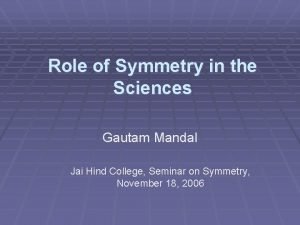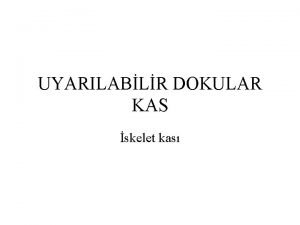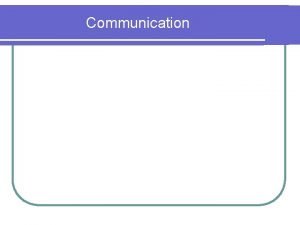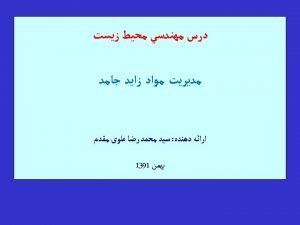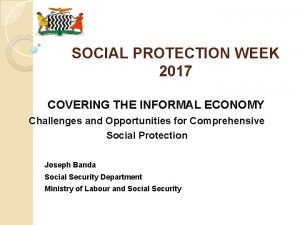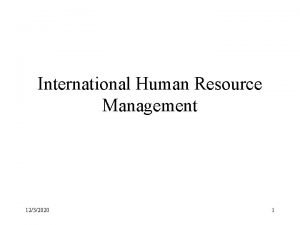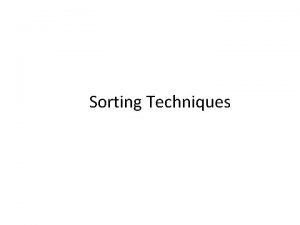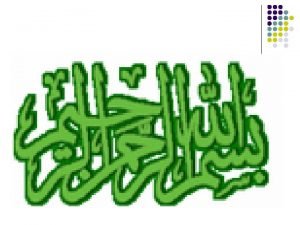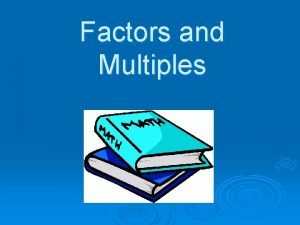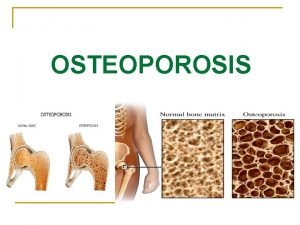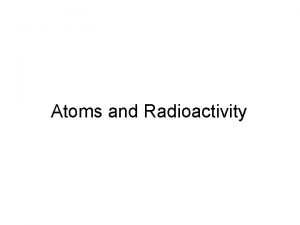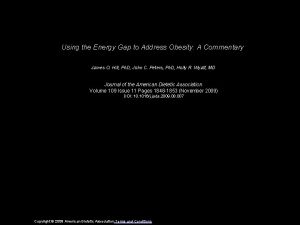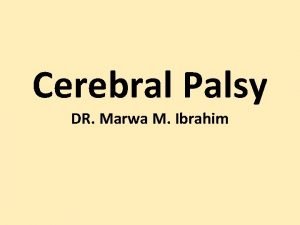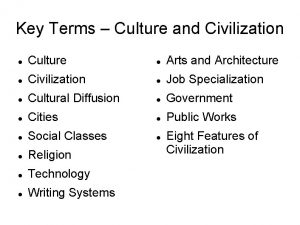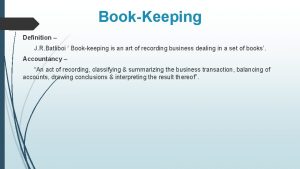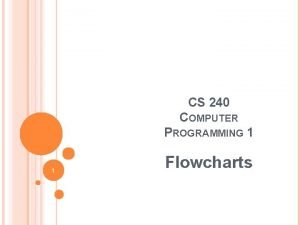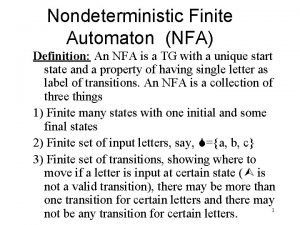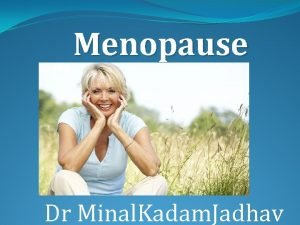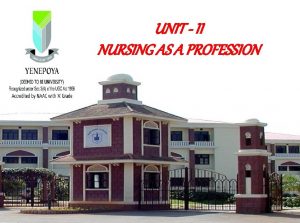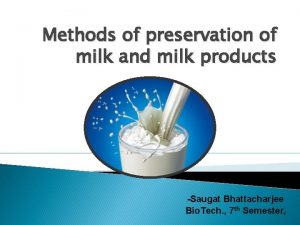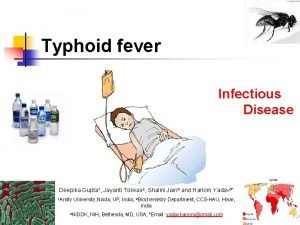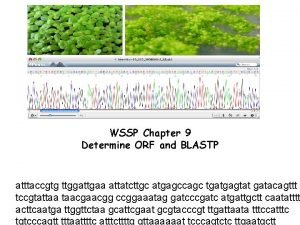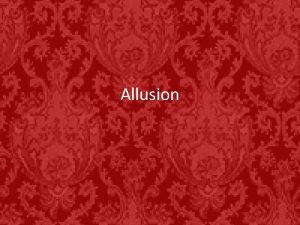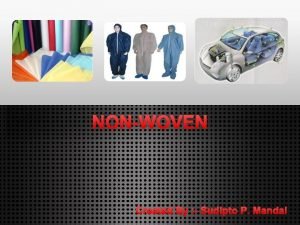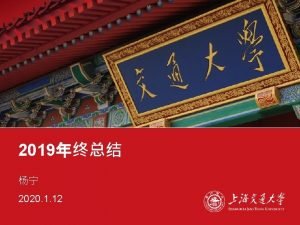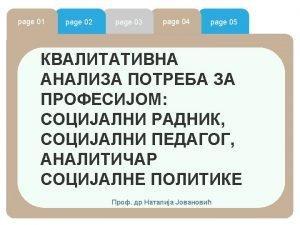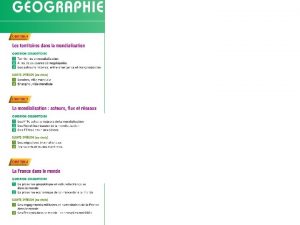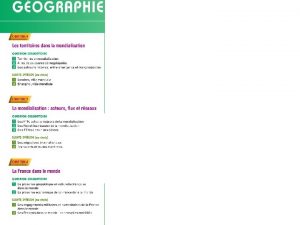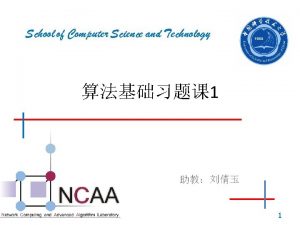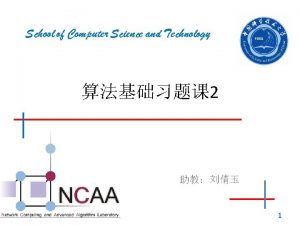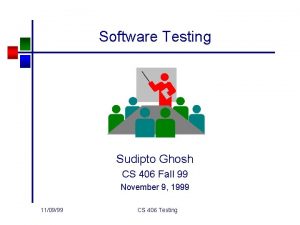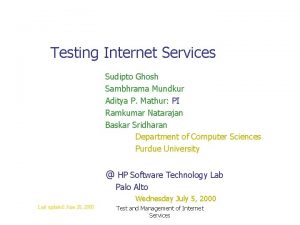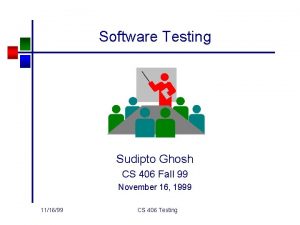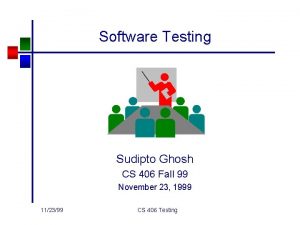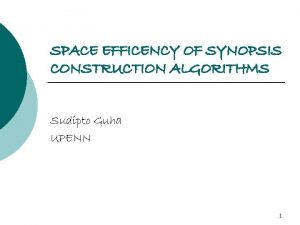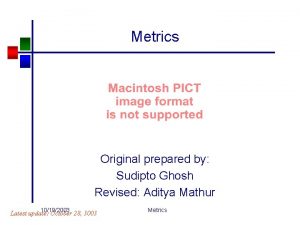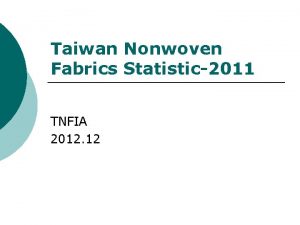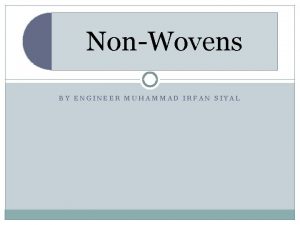NONWOVEN Sudipto P Mandal 084050254 Page 1 Defination









































![Stitch bonding Mass per unit area [g/m 2] Preferable mass/unit area [g/m 2] Calendaring Stitch bonding Mass per unit area [g/m 2] Preferable mass/unit area [g/m 2] Calendaring](https://slidetodoc.com/presentation_image_h2/85478c303725d912f6028942d82fa938/image-42.jpg)







- Slides: 49

NON-WOVEN Sudipto P. Mandal 084050254. Page 1

Defination of Non-Wovens “A nonwoven is a sheet of fibres, continuous filaments, or chopped yarns of any nature or origin, that have been formed into a web by any means, and bonded together by any means, with the exception of weaving or knitting. ”

History of Non-Wovens q Were first made from fibrous waste. q Technical & marketing mistakes. q Were first assumed as cheap substitutes. q They were considered as low quality items. q In 1960 s were first used as am application in manufacturing bandages. q Later became an important part of technical textile.

INTRODUCTION TO NON-WOVEN Nonwoven fabric is a fabric-like material made from long fibers, bonded together by chemical, mechanical, heat or solvent treatment. Nonwoven fabrics are broadly defined as sheet or web structures bonded together by entangling fibre or filaments (and by perforating films) mechanically, thermally or chemically. They are not made by weaving or knitting and do not require converting the fibres to yarn. The term is used in the textile manufacturing industry to denote fabrics, such as felt, which are neither woven nor knitted. They are flat, porous sheets that are made directly from separate fibres or from molten plastic or plastic film. They are not made by weaving or knitting and do not require converting the fibres to yarn.

ADVANTAGES OF NON-WOVEN The great advantages in non-woven fabrics is the speed with which the final fabric is produced. All yarn preparation steps are eliminated, and the fabric production itself is faster than conventional methods. To produce 500, 000 meters of woven sheeting requires 2 months of yarn preparation, 3 months of weaving on 50 looms and 1 month for finishing and inspection. Non-woven fabric can deliver the same quantity of sheeting within 2 months from order. Not only are production rate are higher for nonwovens, but the process is more automated, requiring less labour than even most modern knitting or weaving systems. The nonwoven process is also efficient in its use of energy.

Applications q Nonwoven fabrics can be engineered to give a wide variety of properties. q Nevertheless, their aesthetic properties (handle, drape, appearance) are such that they are not in direct competition with conventional fabrics in the outerwear market. q Woven and knitted fabrics will not be replaced by nonwovens in the near future. q Currently, the main areas of growth in nonwovens are in Geotextile, medical and hospital uses, disposable products and filters.

Raw-Material Used for Non-Wovens Cotton Viscose Polyester Polypropylene Polyamide Glass fibers Standard synthetic fibers Nomex cellulosic fibers (viscose & cotton) Nylon PTFE (Teflon), microfibers Mineral fibers High tech fibers (e. g. PEEK), etc.

Production Rate Fabric production method Weaving Rate of fabric production 1 metre/minute Knitting 2 metre/minute Nonwoven 100 metre/minute

Comparison between different rates of production in the manufacture of textiles & similar materials

Market share of different web laying process WEB LAYING PROCESS PERCENTAGE SHARE (%) Dry laid 44 Airlaid 3 Polymer Extrusion 37 Wet laid 16

Manufacturing Process of Non-Wovens There are normally two steps for making non-woven products. 1 Web formation 2 Bonding systems.

Process flowchart for producing nonwoven

Web Formation Methods q A nonwoven fabric is basically a web of fibres held together in some way. q The web may be made of staple fibres or filaments, or from portions of polymer film. Web formation from Staple Fibres 1. Parallel-laid web from carded fibres. 2. Cross Laid-web. 3. Random web. Other Web formation methods 1. Dry Laid. 2. Wet Laid 3. Spun Melt. 4. Electrostatic web formation. 5. Spraying.

Web formation from Staple Fibres 1. Parallel-laid web from carded fibres. q Carding is a time-honored way of making web from staple fibres. q In a carded web the fibres are aligned more or less parallel to each other and to the direction in which the card produces the web. q Such web is stronger when pulled lengthwise than crosswise because there is more friction between the fibre in lengthwise direction. q Carded webs are usually thin, they may be too thin for some nonwoven end-uses. To increase the final thickness, a number of webs can be layered.

Web formation from Staple Fibres 2. Cross Laid-web q. To increase the strength of web in both lengthwise and crosswise directions, cross laid web is used. q. To achieve this, the fibres which make up the web will be orientated equally in both lengthwise and crosswise directions. q. The properties of cross-laid webs do not vary with direction as much as do those of straight-laid web

Web formation from Staple Fibres 3. Random web. q The Rando-Webber creates such a randomly orientated web by blowing the fibres about in a stream of air and then sucking them onto the surface of a perforated drum to form a layer. q This randomizing process produces a remarkably uniform web from staple fibres and with no directionality in properties. q Its webs account for three-quarters of non-woven produced

Other Web formation methods 1. Dry Laid. There are two methods of dry laying: a) Carding. b) Air laying. Carding machine q. It is a revolving drum or series of drums covered in fine metallic wires or teeth. q. Carding is a mechanical process starting with the opening of fibre bales which are blended and conveyed to the next stage by air transport. q. They are after that combed into a web by a carding machine. q. The exact configuration of cards depends on the fabric weight and fibre properties needed. q. The web can be parallel-laid, or can be random-laid. q. The parallel-laid carded webs result in üGood tensile strength, üLow elongation and üLow tear strength in the machine direction and the reverse in the cross direction.

Other Web formation methods 1. Dry Laid.

Other Web formation methods 1. Dry Laid. Air laying: q Generally tiny fibres are fed into an air flow. q From here it goes on to a moving belt or perforated drum, where they form a randomly oriented web. q Air laid webs gives greater adaptability in terms of the fibres and fibre blends that can be used. q Compared with carded webs, air laid webs has lower density, greater softness and the laminar structure is absent.

Other Web formation methods 1. Dry Laid. Air laying:

Other Web formation methods 2. Wet Laid. q The method of wet laying is similar to paper manufacturing but with synthetic fibres. q Dilute slurry of water and fibres is dumped on a moving wire screen and drained to form a web. q After that with the help of pressing between rollers the web is dewatered, consolidated and then dried out. Impregnation with binders is frequently integrated in a later phase of the progression.

Other Web formation methods 2. Wet Laid.

Other Web formation methods 3. Spun Melt. Spun melt is a generic term describing the manufacturing of nonwoven webs directly from thermoplastic polymers. It consists of two processes: a) Spun laid b) Melt blown Spun laid process q. Also known as spun bonded. q. Polymer granules are melted and then the molten polymer is extruded throughout spinnerets. q. Then the continuous filaments are chilled and dump on to a conveyor belt to structure a uniform web. q. In the spun laid method, the raw material elasticity is more controlled; however it gives the nonwovens superior strength. Co-extrusion of second components is used in numerous spun laid methods, generally to provide extra properties or bonding potential.

Other Web formation methods 3. Spun Melt blown q In melt blown process web is formed by comparatively low viscosity polymers which are extruded into a high velocity air stream. q This distributes the melt, solidifies it and breaks it up into a fibrous web.

Other Web formation methods 4. Electrostatic web formation. . q. In electrostatic laying, fine fibres are given a static electric charge between the plates of a condenser. q. They are then allowed to fall on a moving belt to form a randomly orientated but uniform web. q. As specified above specialize technology the most important is the electrostatic spinning, where mainly fibrillation takes place to form the web.

Other Web formation methods 5. Spraying. . q. Short thermoplastic fibres can be SPRAYED onto a belt to produce a random web. q. The are subsequently fused by the application of heat and pressure. ***

Web Bonding Methods q As soon as the web is formed it has a little strength which doesn’t match the requirement of the customers. So it becomes very necessary to bond the web & for that method many choice are available. q The main criterion of choice of any web bonding technology entirely depends on the functional properties. There are three basic types of bonding: a) Chemical b) Thermal c) Mechanical THERMAL BONDING CHEMICAL BONDING MECHANICAL BONDING

Web Bonding Methods A) Chemical bonding q. In chemical bonding normally web is bonded with the help of some binding agent generally refer as binder. q. Three groups of materials are commonly used as binders: üAcrylate polymers and copolymers üStyrene-butadiene copolymers üVinyl acetate ethylene copolymers. q. The method of applying binder are üImpregnating üCoating üSpraying q. The binders should necessary to apply homogeneously for better property gaining

CHEMICAL BONDING Spray bonding q. In spray bonding, binders are sprayed onto moving webs. q. Spray bonding is used for fabric applications that which require the maintenance of highloft or bulk, such as fiberfill and air-laid pulp wipes. q. The binder is atomized by air pressure, and is applied to the upper surfaces of the web in fine droplet form through a system of nozzles.

TYPES OF BINDERS USED IN CHEMICAL BONDING • Polyvinyl Chloride (PVC): The homopolymer of polyvinyl chloride is a very hard, rigid polymer • Styrene-Butadiene (S/B, SB, or styrene butadiene rubber): These binders have an excellent combination of flexibility and toughness. • Vinyl Acrylics: These binders are more hydrophobic than the straight VAC binders. They provide excellent toughness, flexibility, and better color stability. • Vinyl Acetate (VAC): The vinyl acetate binders are firm. • Styrenated Acrylics: These are tough, hydrophobic binders. • Acrylic: These binders offer the greatest durability, color stability, and dry/wet performance.

Web Bonding Methods B) Thermal bonding (cohesion bonding) q. In thermal bonding the controlled heat is applied for bonding the non woven fabrics. q. And this type of bonding is applied to raw materials which are thermoplastic in nature. q. Here a low melt fibre or bicomponent fibre is introduced at the web formation stage to perform the binding function later in the process but the web fibre itself can be used. q. There are several thermal bonding systems in use: üCalendar bonding. üThrough-air thermal bonding. üDrum and blanket systems. üSonic bonding.

Calender Bonding

Ultra Sonic Bonding

Web Bonding Methods C) Mechanical bonding There are three major types of mechanical bonding: üNeedle punching üHydro-entanglement üStitch bonding 1) Needle punching q. Needle Punching is usually used for manufacturing geo-textiles. q. Especially designed needles are hard-pressed and pulled throughout the web to entangle the fibres for proper bonding.

INTRODUCTION TO NEEDLE PUNCHING The needle punch process is illustrated in fig. Needle punched nonwovens are created by mechanically orienting and interlocking the fibers of a spunbonded or carded web. This mechanical interlocking is achieved with thousands of barbed felting needles repeatedly passing into and out of the web.

PROCESS OF NEEDLE PUNCHING • Needle punching is carried out passing a number of needles with barbs, mounted in a board, through the batt at a high reciprocating speed. • Needles are arranged in a number of rows (up to 23 -26) in a needle board with about 1500 to 5000 needles per 1 m working width. • The needles are usually triangular in cross-section with barbs at the three edges. • As the needle penetrates through the batt, the barbs carry fibres with them thereby causing mechanical entanglement of fibres. • This gives strength and dimensional stability to the batt.

• Punch density is dependent upon the number of needles per board, number of boards, stroke frequency and delivery rate. • Stroke frequency is indicated by the number of up and down strokes made by the needle board per min. This is usually 1000 in old machines and has gone up progressively upto 3000 in latest models. • Width of needle punching machine ranges from 2 to 10 m.

TYPES OF NEEDLES USED IN NEEDLE PUNCHING Thus finer the needles, higher the punch density. Coarse fibers use the lower punch density, and fine fibers and delicate fibers use the higher punch density. For example, a coarse fiber product may use a 12 to 16 punch density and fine synthetics may use 25 to 40 punch density.

WORKING OF NEEDLES

Web Bonding Methods C) Mechanical bonding 2) Hydro entanglement q Hydro Entanglement uses high pressure jets of water to cause the fibres to interlace. q It is mainly applied to carded or wet laid webs. q The water jet pressure used has a direct bearing on the strength of the web, but system design also plays a part. q Hydro entanglement is sometimes known as spun lacing. 3) Stitch bonding q. Stitch bonding a third type of mechanical bonding. q. It can be done with or without the addition of a thread. q. When no thread is added, the process is often referred to a loop formation.

Hydro entanglement . SCENE 3
![Stitch bonding Mass per unit area gm 2 Preferable massunit area gm 2 Calendaring Stitch bonding Mass per unit area [g/m 2] Preferable mass/unit area [g/m 2] Calendaring](https://slidetodoc.com/presentation_image_h2/85478c303725d912f6028942d82fa938/image-42.jpg)
Stitch bonding Mass per unit area [g/m 2] Preferable mass/unit area [g/m 2] Calendaring 5– 120 5– 80 Thermo fusion 60– 500 80– 400 Needle-punching 60– 1000 100– 400 STITCH-BONDING 80– 1000 100– 400 Mode of bonding Thermal Mechanical Hydrodynamic 20– 400 30– 200

ADVANTAGES OF NON-WOVEN FABRICS 1 2 3 4 5 6 SCENE Greater strength per basis weight than competing fabrics High levels of uniformity High tear and tensile strength Dimensional stability Consistency in high temperature applications Application-specific engineering. .

USE OF VARIOUS NON-WOVEN PRODUCTS Interlining Filter Used in Garments, Shoes Inners GSM – 35 to 150 Cotton Filters Used as Pharmaceutical Filters, Hygienic Filters (Sugar Factory), Molasis Filtration (Alcohol, Beverages) GSM – 130 to 400 High Loft Air Filter Used as special Air Filter (For Air conditioner) GSM – 150 to 300 Dust Catchers Used Mostly in Cement Industry GSM – 270 to 300 Combustion Filters Used in Automobile Industry Geo Textile Used in Mega Civil Construction GSM – 200 to 400 Channeling Felt Used in Window Channeling Field of Application – Automobiles (Cars/Luxury Interiors), Aero plane Windows GSM – 530 to 1178

NTERLINING FILTER COTTON FILTERS HIGH LOFT FILTERS CEMENT DUST CATCHERS GEO-TEXTILES CHANNELING FELT

APPLICATIONS OF NON-WOVEN Hygiene • baby diapers or nappies • wet wipes • bandages and wound dressings • disposable bath and face towels • disposable slippers and footwear Medical • isolation gowns • surgical drapes and covers • surgical scrub suits • caps • medical packaging. Filters • gasoline, oil and air -filtration • water, coffee, tea bags • pharmceutical industry • mineral processing • liquid cartridge and bag filters Geotextiles • soil stabilizers and roadway underlayment • foundation stabilizers • erosion control • canals construction • drainage systems • pond and canal water barriers • sand infiltration barrier for drainage tile

APPLICATION OF NONWOVENS 1. AGRO TEXTILES 7. MEDICAL TEXTILES • Agro bags • Artificial skin • Agro Protective Garments • Bandages • Frost protection covers • Caps 2. BUILDING TEXTILES 8. AUTOMOBILE TEXTILES Architectural Composites • Auto hose Fabric Awnings • Boot liners Canopies • Cabin filters 3. CLOTHING TEXTILES 9. OEKO TEXTILES Clean room garments • Industrial Hazardous waste disposal products Interlinings • Other Oekotech Applications Labels • Solid waste disposal Products 4. GEO TEXTILES 10. PACKAGING TEXTILES Geomembranes FIBC Nonwoven Geotextile Food packaging fabric Other Geotech Applications Other Packtech Applications 5. HOME TEXTILES 11. PROTECTIVE TEXTILES • Blanket • Chemical Protection • Blinds • Dust protection fabrics • Composites • Electrical protective clothing 6. INDUSTRIAL TEXTILES 12. SPORTS TEXTILES • Abrasives Fabrics • Artificial turf • Battery separator fabric • Boat cover

References http: //www. technicaltextile. net http: //www. scribd. com/doc/19791954/ http: //dc 311. 4 shared. com/doc/Qt 7 sg. N 1 P/preview. html http: //www. inda. org/ http: //en. wikipedia. org/wiki/Nonwoven_fabric

Thank You
 Nonwoven construction adhesive
Nonwoven construction adhesive Gautam mandal tifr
Gautam mandal tifr Mandals in siddipet district
Mandals in siddipet district Dr sanat mandal
Dr sanat mandal Nagalgidda mandal villages list
Nagalgidda mandal villages list Kas kasılması aktin miyozin
Kas kasılması aktin miyozin Sanjit mandal california seo professionals
Sanjit mandal california seo professionals उद्दीपकाचे
उद्दीपकाचे Apa standard reference
Apa standard reference Impatitis
Impatitis Contract definition
Contract definition Define communication objectives
Define communication objectives Meaning interview
Meaning interview Flow chart of transfer station
Flow chart of transfer station Defination of informal sector
Defination of informal sector Hci definition
Hci definition Costs and benefits of free trade
Costs and benefits of free trade Human resource management meaning
Human resource management meaning Specifies the way to arrange data in a particular order.
Specifies the way to arrange data in a particular order. Areolar connective tissue cell type
Areolar connective tissue cell type Drug form definition
Drug form definition Defination
Defination What are first 10 prime numbers
What are first 10 prime numbers Defination of osteoporosis
Defination of osteoporosis Deflection of alpha beta and gamma in a magnetic field
Deflection of alpha beta and gamma in a magnetic field Defination of stress
Defination of stress Position vector meaning
Position vector meaning Class 5 factors and multiples
Class 5 factors and multiples Obesity defination
Obesity defination Cerebral palsy defination
Cerebral palsy defination Environmental science final
Environmental science final Defination of civilization
Defination of civilization J.r. batliboi
J.r. batliboi Defination of flow chart
Defination of flow chart Defination of nfa
Defination of nfa Hearsay legal
Hearsay legal Triage medical definition
Triage medical definition Leverage analysis meaning
Leverage analysis meaning Minal jadhav
Minal jadhav Definitions of nursing
Definitions of nursing Nursing defination
Nursing defination Hydrophobia synonyms
Hydrophobia synonyms Milk preservation methods
Milk preservation methods Isp defination
Isp defination Typhoid fever
Typhoid fever Orf
Orf Defination of cyst
Defination of cyst Algorithm defination
Algorithm defination What is an allusion
What is an allusion What is hearsay
What is hearsay

